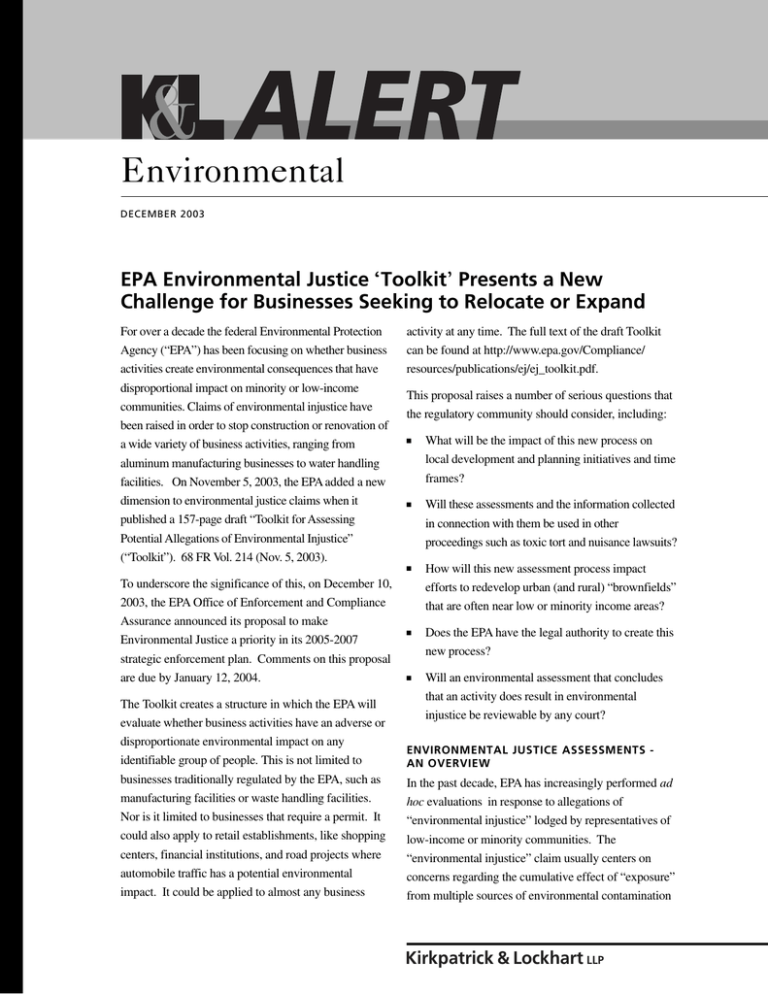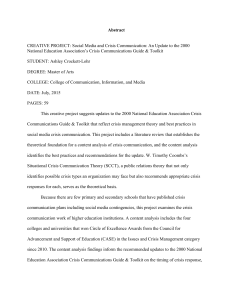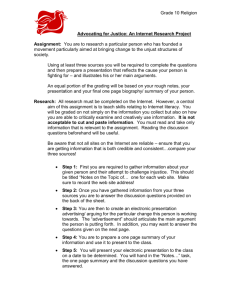
Environmental
DECEMBER 2003
EPA Environmental Justice Toolkit Presents a New
Challenge for Businesses Seeking to Relocate or Expand
For over a decade the federal Environmental Protection
Agency (“EPA”) has been focusing on whether business
activities create environmental consequences that have
disproportional impact on minority or low-income
communities. Claims of environmental injustice have
been raised in order to stop construction or renovation of
a wide variety of business activities, ranging from
aluminum manufacturing businesses to water handling
facilities. On November 5, 2003, the EPA added a new
dimension to environmental justice claims when it
published a 157-page draft “Toolkit for Assessing
Potential Allegations of Environmental Injustice”
(“Toolkit”). 68 FR Vol. 214 (Nov. 5, 2003).
To underscore the significance of this, on December 10,
2003, the EPA Office of Enforcement and Compliance
Assurance announced its proposal to make
Environmental Justice a priority in its 2005-2007
strategic enforcement plan. Comments on this proposal
are due by January 12, 2004.
The Toolkit creates a structure in which the EPA will
evaluate whether business activities have an adverse or
disproportionate environmental impact on any
identifiable group of people. This is not limited to
businesses traditionally regulated by the EPA, such as
manufacturing facilities or waste handling facilities.
Nor is it limited to businesses that require a permit. It
could also apply to retail establishments, like shopping
centers, financial institutions, and road projects where
automobile traffic has a potential environmental
impact. It could be applied to almost any business
activity at any time. The full text of the draft Toolkit
can be found at http://www.epa.gov/Compliance/
resources/publications/ej/ej_toolkit.pdf.
This proposal raises a number of serious questions that
the regulatory community should consider, including:
n
What will be the impact of this new process on
local development and planning initiatives and time
frames?
n
Will these assessments and the information collected
in connection with them be used in other
proceedings such as toxic tort and nuisance lawsuits?
n
How will this new assessment process impact
efforts to redevelop urban (and rural) “brownfields”
that are often near low or minority income areas?
n
Does the EPA have the legal authority to create this
new process?
n
Will an environmental assessment that concludes
that an activity does result in environmental
injustice be reviewable by any court?
ENVIRONMENTAL JUSTICE ASSESSMENTS AN OVERVIEW
In the past decade, EPA has increasingly performed ad
hoc evaluations in response to allegations of
“environmental injustice” lodged by representatives of
low-income or minority communities. The
“environmental injustice” claim usually centers on
concerns regarding the cumulative effect of “exposure”
from multiple sources of environmental contamination
Kirkpatrick & Lockhart LLP
(e.g., air emissions, water discharges or contaminated
soil or groundwater), which adversely and
disproportionately impact residents. These
communities often assert claims to prevent the approval
of new or expanded business activities, based on
concerns regarding additional sources of potential
contamination.
However, claims are often also based on community
displeasure with unregulated nuisance conditions, such
as noise, odors, and truck traffic, or even the nature of
the business (biotech or other seemingly “mysterious”
businesses). Residents in urban and rural communities
alike have begun to seize on regulatory approvals under
a variety of environmental laws such as the Clean Air
Act and the Clean Water Act to assert an environmental
injustice claim associated with a pending approval as a
way to obtain relief from regulatory agencies on a
much wider range of perceived problems, including
unregulated activities and conditions, or other
community needs.
THE PROPOSED TOOLKIT
The Toolkit not only proposes to create a “process” for
responding to claims of potential environmental
injustice, but also proposes to proactively address
concerns over environmental injustice. Under the
proposal, this new process for developing environmental
injustice assessments apparently can be triggered by the
Agency itself, even though no complaint has been filed
and no permit is being considered.
The proposal presents a several-step process for
conducting an assessment. Assessments begin with
delineation of the community affected or potentially
affected, and a reference community for comparison.
After consulting with the affected community (again,
whether or not a complaint has been filed), a problem
statement of the conditions causing any potential
environmental injustice is formulated. Then
appropriate indicators are selected to measure existing
environmental, health, social and economic conditions
in the community against which additional impacts
being contemplated can be measured.
Many of the indicators suggested in the Toolkit present
interesting questions. For example, the Toolkit
suggests that a factor in favor of finding environmental
injustice caused by a proposed or ongoing activity is
whether individuals living near the facility are more
susceptible to contamination from the facility because
they choose to smoke cigarettes, drink alcohol or use
drugs. A number of other significant issues are
presented by the use, and potential misuse, of
assessments, including their use where the Agency’s
jurisdiction or authority is questionable.
Will the assessment be used to evaluate impacts of
nonregulated activities and conditions?
The Toolkit portends an expansive use of environmental
injustice assessments. For instance, an assessment could
be conducted using the Toolkit to resolve allegations of
environmental injustice based upon noise, odors or other
nuisance conditions and matters over which the EPA has
no jurisdiction. Assessments also could be conducted at
the request of a community to review historical and
existing conditions. Further, assessments prompted by
allegations of environmental injustice are not necessarily
limited to low-income or minority areas, but could be
conducted in any community, regardless of demographic
composition, according to the Toolkit. The EPA
contemplates conducting assessments using the Toolkit
in connection with the preparation of Environmental
Impact Statements under the National Environmental
Policy Act (“NEPA”) (for all federally funded projects,
for example), rulemakings, priority setting and
enforcement targeting. This is particularly significant in
light the agency’s proposal that Environmental Justice
be an enforcement priority beginning in 2005.
Will the results of the assessment be used in collateral
proceedings?
There seems to be no limit on the use of an assessment
conducted in response to an environmental injustice
allegation or administrative initiative. Information
collected and findings made by the EPA following an
assessment under the Toolkit appear to be public and
may be available for use as evidence in any subsequent
legal proceedings, including nuisance or toxic tort
KIRKPATRICK & LOCKHART LLP ENVIRONMENTAL ALERT
actions. The formality associated with assessments
under the Toolkit may add credibility to the conclusions
reached by the EPA, whether or not merited, in another
context.
Does the Agency have the statutory authority to create
these procedures and conduct these assessments?
The source and scope of the Agency’s authority to
conduct environmental injustice assessments is unclear.
The EPA has no specific substantive statutory authority
to undertake environmental justice assessments as part
of determining the environmental impact of particular
activity under laws that it administers. Instead, the
Agency’s asserted authority to conduct environmental
injustice assessments purports to be based on its
authority under various statutes to develop information
relevant and necessary to review a permit or to
implement another statutory function. But the EPA
does not limit its use of this Toolkit to actual permit
proceedings under these statutes. The soundness of this
premise is open to question.
Nor does it specify whether or how a record (if any)
would be created for purposes of administrative or
judicial review. Further, it is unclear whether this
proceeding may be used to stall an otherwise timely
permit or other regulatory proceeding.
There are many other questions raised by this 157-page
proposal. Its implementation potentially impacts the
regulated community in profound ways. It is important
that potentially affected persons and entities review it
carefully and, where appropriate, submit comments on
the draft to make sure that this important principle does
not become just another way to raise “NIMBY” issues.
BARRY M. HARTMAN
bhartman@kl.com
202.778.9338
BRIAN S. MONTAG
bmontag@kl.com
973.848.4044
CRAIG P. WILSON
cwilson@kl.com
717.231.4509
Will decisions made using the Toolkit that harm a
business activity be subject to review by a court?
The Toolkit suggests that many critical decisions about
the formulation of an assessment and the conclusions
reached following an assessment are determined by
Agency employees, who are directed to consult with
the affected community and “other stakeholders.” But
the Toolkit does not ensure that directly affected parties
that become the subject of an environmental injustice
allegation have an opportunity to participate in or even
comment on these decisions.
The Toolkit states that the adequacy of an
environmental injustice assessment may be appealed to
the Environmental Appeals Board (a non-statutory
entity that is created in the EPA Administrator’s office),
presumably by the third party that sought or prompted
the assessment. However, the Toolkit does not indicate
who else would have standing to appeal such decisions.
FOR MORE INFORMATION about this Alert or Kirkpatrick &
Lockhart’s environmental practice, please contact the authors or one
of the K&L office contacts below. You may also visit our website at
www.kl.com.
Michael DeMarco
Robert Everett Wolin
R. Timothy Weston
Frederick J. Ufkes
Daniel A. Casey
William H. Hyatt, Jr.
Warren H. Colodner
Richard W. Hosking
Edward P. Sangster
Barry M. Hartman
Boston
Dallas
Harrisburg
Los Angeles
Miami
Newark
New York
Pittsburgh
San Francisco
Washington
617.951.9111
214.939.4909
717.231.4504
310.552.5079
305.539.3324
973.848.4045
212.536.3912
412.355.8612
415.249.1028
202.778.9338
mdemarco@kl.com
rwolin@kl.com
tweston@kl.com
fufkes@kl.com
dcasey@kl.com
whyatt@kl.com
wcolodner@kl.com
rhosking@kl.com
esangster@kl.com
bhartman@kl.com
®
Kirkpatrick & Lockhart LLP
Challenge us. ®
www.kl.com
BOSTON
n
DALLAS
n
HARRISBURG
n
LOS ANGELES
n
MIAMI
n
NEWARK
n
NEW YORK
n
PITTSBURGH
n
SAN FRANCISCO
n
WASHINGTON
.........................................................................................................................................................
This publication/newsletter is for informational purposes and does not contain or convey legal advice. The information herein
should not be used or relied upon in regard to any particular facts or circumstances without first consulting a lawyer.
DECEMBER 2003
LLP. ALL RIGHTS RESERVED.
© 2003 KIRKPATRICK & LOCKHART
Kirkpatrick
& Lockhart LLP
75 State Street
Boston, Massachusetts 02109
617.261.3100 PHONE
617.261.3175 FAX
2828 North Harwood Street
Suite 1800
Dallas, Texas 75201
214.939.4900 PHONE
214.939.4949 FAX
Payne Shoemaker Building
240 North Third Street
Harrisburg, Pennsylvania 17101
717.231.4500 PHONE
717.231.4501 FAX
10100 Santa Monica Boulevard
Seventh Floor
Los Angeles, California 90067
310.552.5000 PHONE
310.552.5001 FAX
Miami Center - 20th Floor
201 South Biscayne Boulevard
Miami, Florida 33131
305.539.3300 PHONE
305.358.7095 FAX
One Newark Center, 10th Floor
Newark, New Jersey 07102
973.848.4000 PHONE
973.848.4001 FAX
599 Lexington Avenue
New York, New York 10022
212.536.3900 PHONE
212.536.3901 FAX
Henry W. Oliver Building
535 Smithfield Street
Pittsburgh, Pennsylvania 15222
412.355.6500 PHONE
412.355.6501 FAX
Four Embarcadero Center, 10th Floor
San Francisco, California 94111
415.249.1000 PHONE
415.249.1001 FAX
1800 Massachusetts Avenue, N.W.
Second Floor
Washington, DC 20036
202.778.9000 PHONE
202.778.9100 FAX
®
www.kl.com
Kirkpatrick & Lockhart LLP
Challenge us.
®




